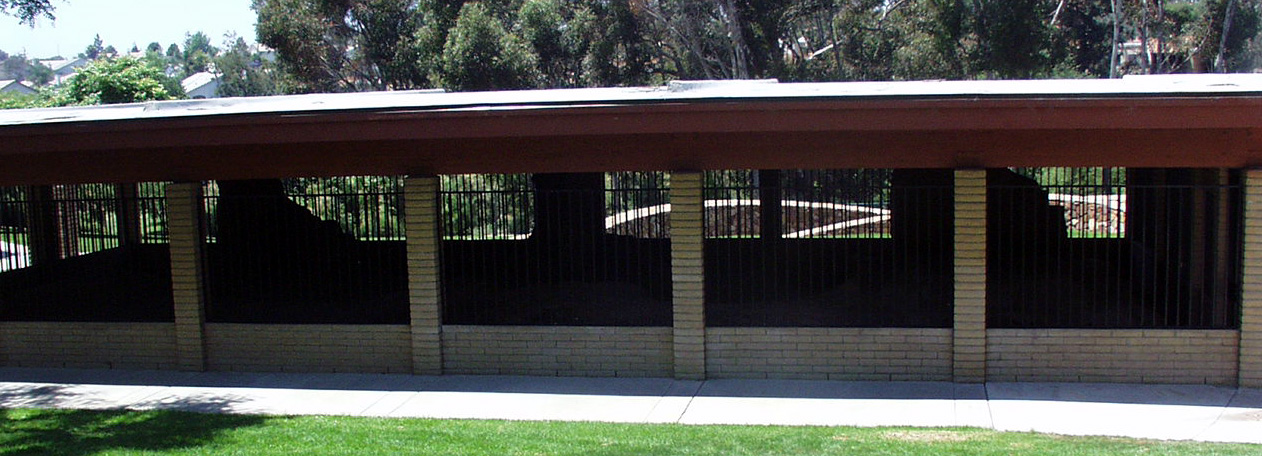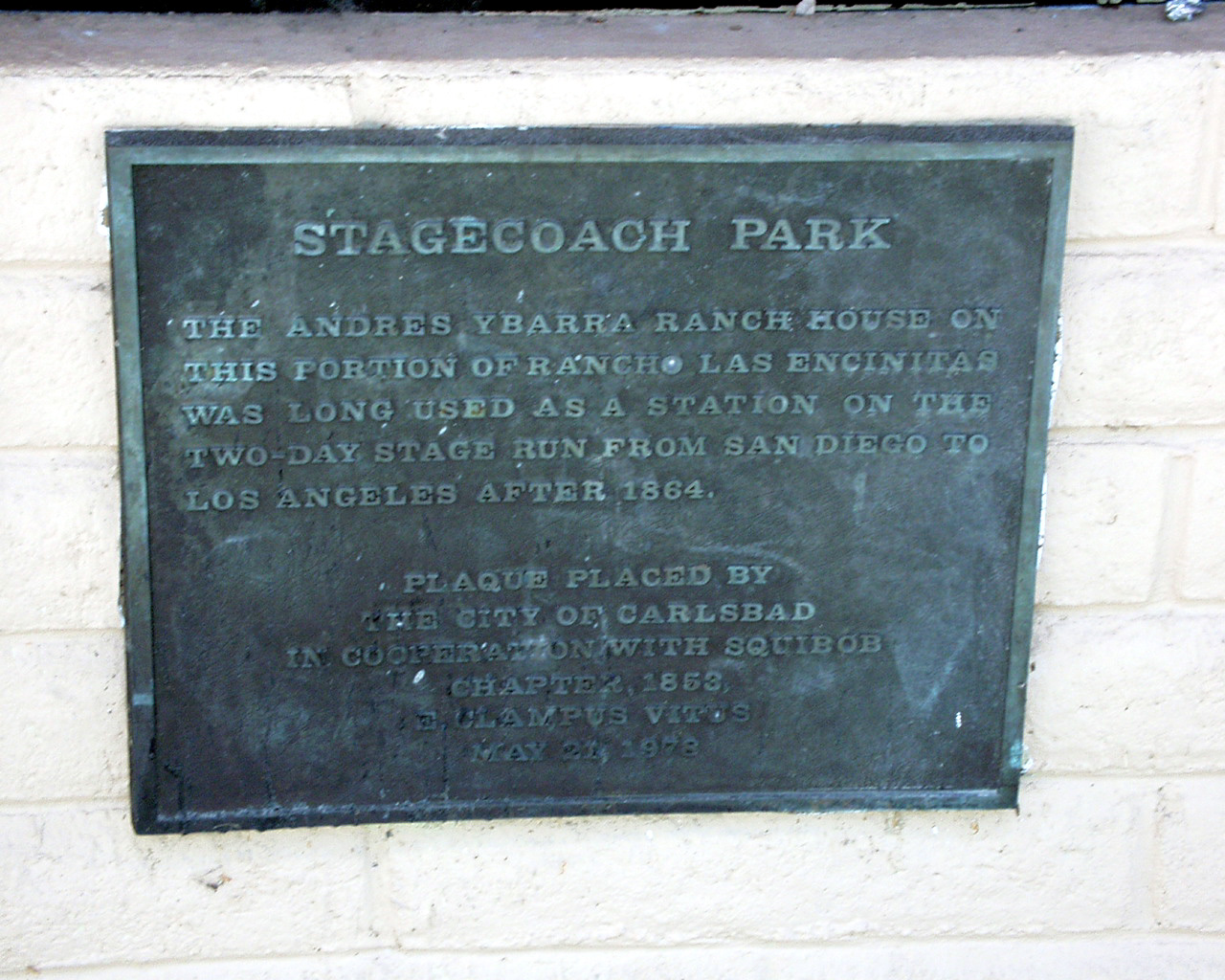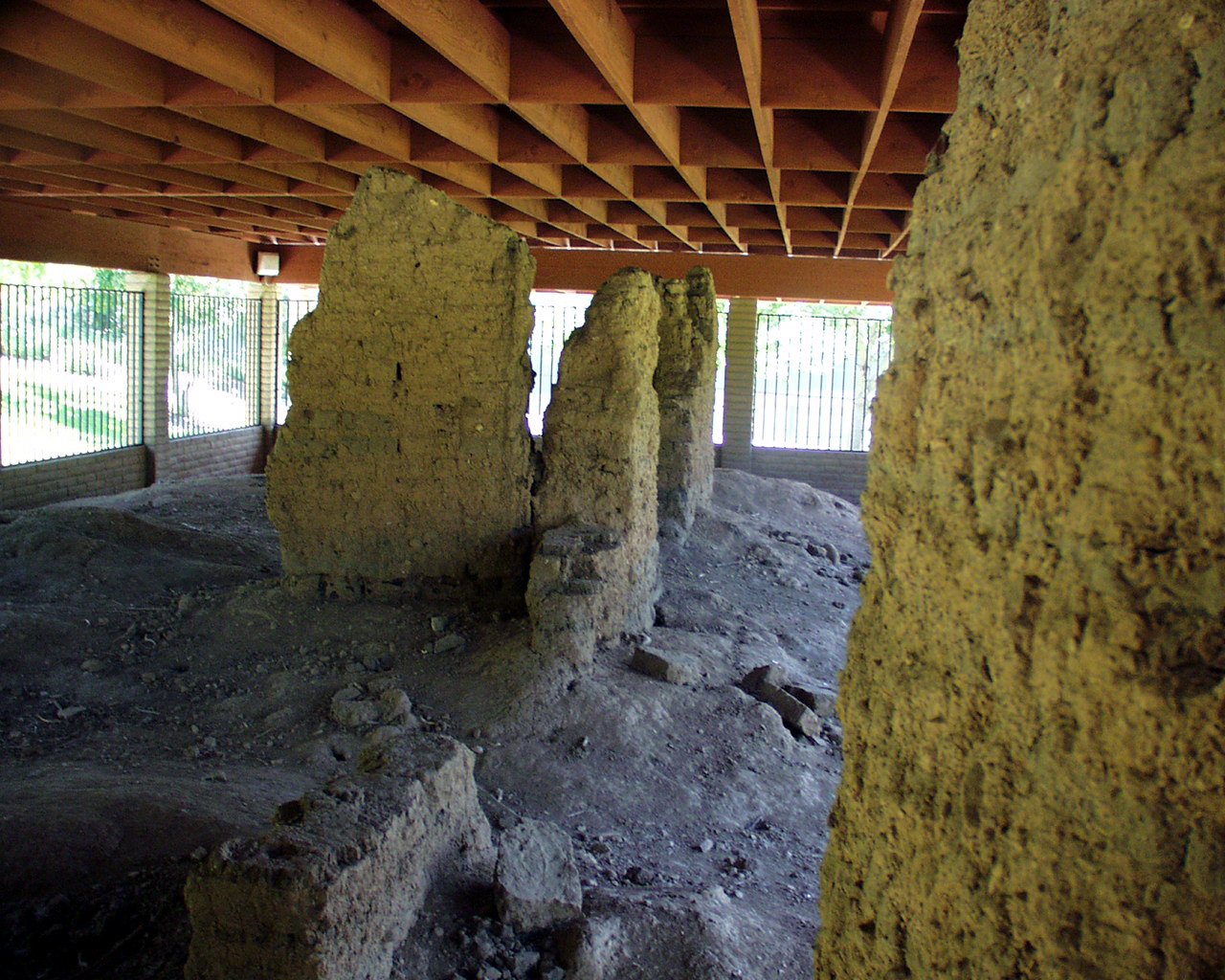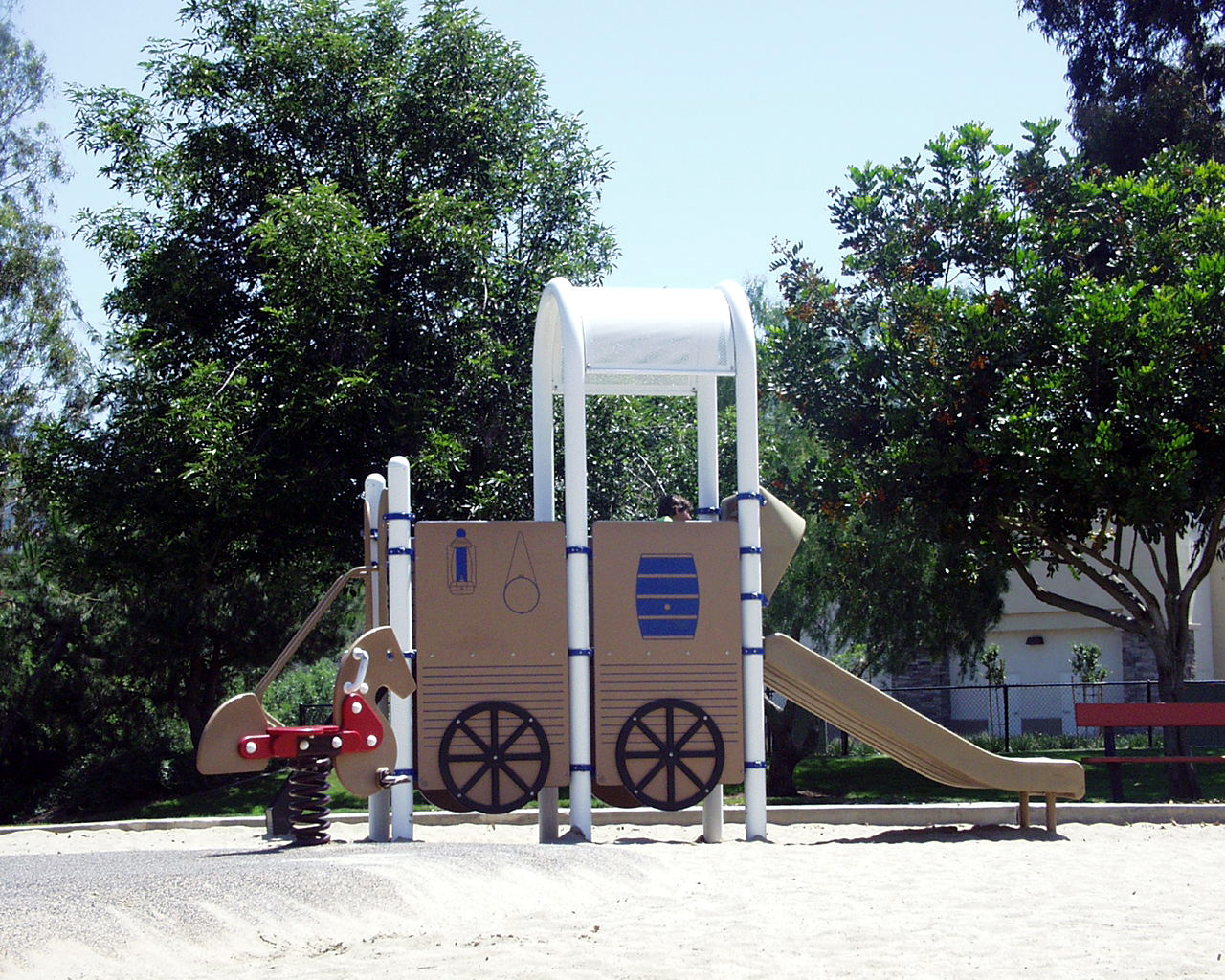|

Protected environment—The adobe ruins in Stagecoach Community
Park are enclosed inside a protective structure
By Donald H. Harrison
CARLSBAD, Calif.—Stagecoach Community Park today is a combination of ball
fields, picnic areas, a community activities building, and, under a
protective structure, the mysterious-looking ruins of an old adobe building,
identified by plaque as the Andres Ybarra ranch house. The plaque says it had
been used as a station on the two-day San Diego to Los Angeles stagecoach run
after 1864.
 However,
the
plaque explaining the ghostly remains doesn't say that by the time the building
was used for a stagecoach stop, the 4,321-acre Ybarra rancho had been sold to
the mercantile firm of J.S. Mannasse & Co, in which Joseph S. Mannasse and
Marcus Schiller, two members of San Diego County's pioneering Jewish community,
were equal partners. However,
the
plaque explaining the ghostly remains doesn't say that by the time the building
was used for a stagecoach stop, the 4,321-acre Ybarra rancho had been sold to
the mercantile firm of J.S. Mannasse & Co, in which Joseph S. Mannasse and
Marcus Schiller, two members of San Diego County's pioneering Jewish community,
were equal partners.
The merchants, who operated a general store, stables, and a lumber company in
San Diego, had purchased Rancho Las Encinitas from Ybarra for $3,000,
mostly because it provided good pasture land on which to raise cattle.
Mannasse and Schiller hoped that the land would prove valuable not only for
grazing. On New Year's Day, 1864, they and six visitors to the ranch
located a mine that they hoped would prove to be rich in silver and copper ore,
although there is no evidence their dreams came true. The two partners, Louis
Rose, E.W. Morse, Joshua Sloan, A. Adams, A.W. Luckett and I. Rent each
filed claims for 200 feet of their find, along with another 200 feet "by
right of discovery." The claim was located about 300 feet north of the
Encinitas Silver and Copper Lode. The New Year's celebrants named their
mine the Saint David Silver & Copper Lode.
When Alfred Seeley, a friend and neighbor in San Diego, decided to start up his
own stagecoach line, the adobe house and nearby barn seemed a good place for
horses to be changed and for passengers to be refreshed en route to Los
Angeles..
 The
prominence of Jewish merchants in San Diego's early history is illustrated by
the fact that initially the stage left Old Town San Diego from the Franklin
House, a hotel named after Jewish merchants, Lewis Franklin and his brother,
Maurice. They had added a story to the old two-story Express Hotel to turn
the building into San Diego's "skyscraper"—Old Town's only
three-story structure. The
prominence of Jewish merchants in San Diego's early history is illustrated by
the fact that initially the stage left Old Town San Diego from the Franklin
House, a hotel named after Jewish merchants, Lewis Franklin and his brother,
Maurice. They had added a story to the old two-story Express Hotel to turn
the building into San Diego's "skyscraper"—Old Town's only
three-story structure.
The Franklins had lived in San Diego, and battled each other, during the
1850s. The two English-born brothers originally had hoped to divide
profits from a hotel, saloon, and general store in the building, but Lewis could
not get along with his younger brother's wife, Victoria. Their quarreling
got so bad that Victoria refused to come down to the dining room for
meals—unless Franklin was absent. Finally the brothers split their
assets in a messy court case that served as entertainment for the town folk of
San Diego, whose interest in litigation was assured by the near absence of any
other public amusements in San Diego.
Today in the archives of the San Diego Historical Society in Balboa Park, some
of the stories of San Diego's stagecoach era have been collected. Material
on file there tell us that in 1868, from the Franklin House, Seeley's
"United States Mail stage" left at 5 a.m. every Monday, Wednesday and
Friday. The Concord stage, pulled by four horses, made stops at San
Diegita (San Dieguito), Encinitas, San Luis Rey, Las Flores, San
Juan Capistrano, Anaheim, and Los Nietos (West Whittier) before arriving
the following day at 7 p.m. in Los Angeles. Passengers stayed over the first
night in San Juan Capistrano.
Place names have changed over the years. The adobe ruins today are located in
the eastern portion of the City of Carlsbad, and not in the nearby City of
Encinitas, which names itself after the rancho. As the rancho of the
"little live oaks" stretched over an entire square league, some of its former grazing lands are now
within the limits of the City of Encinitas. In between the time they were owned
by J.S. Mannasse & Co. and the time they became part of modern Encinitas, they
were possessed by a succession of owners, including a German-speaking, olive-growing colony known as Olivenhain.
That settlement's old meeting house still is standing today.
In December 1869, Seeley switched his stage coach terminus in San Diego from the Franklin House to the
old Casa de Bandini. He renamed this building the Cosmopolitan Hotel, adding a second
story to the old casa.. The Casa de Bandini had a fabled history. It had
been the home of Juan Bandini, a Peruvian immigrant to Mexican San Diego who,
unlike many of the other townspeople in San Diego, supported the Americans in
the Mexican-American War of 1846.
Commodore Robert Stockton made the Casa de Bandini his headquarters immediately
after American forces occupied San Diego, and the story is told that from
household textiles Bandini's daughters sewed the first American flag to fly over
the nearby plaza, which was renamed as Washington Square. When American forces
were outflanked and outfought by Californios in the Battle of San Pascual, the
scout Kit Carson made his way from the battle zone near today's Wild Animal Park
to the Casa de Bandini to
tell the news to Stockton. The commodore ordered his forces to come to the rescue of the
besieged American forces.
A cultured man, Bandini enjoyed hosting fandangos for the American officers and
the local gentry, and is said to have introduced the waltz to California.
Active in the small town's affairs, he served as an alcalde, or mayor, of early
San Diego.
The Bandinis maintained a store in their adobe, but in the mid 1850s they
rented it to Jewish businessman Jacob Elias of Los Angeles, who, in turn, sold
the business to his employee, Heyman Mannasse—the brother of Joseph.
Like the Franklin brothers, the Mannasse brothers had difficulty getting along,
and like the Franklins, some of their troubles had to do with a woman.
In what was considered the premiere Jewish social event of 1863, Hannah Schiller
and Heyman Mannasse were married in a ceremony officiated by San Diego's
earliest Jewish settler, Louis Rose, then a 13-year resident of the outpost
town. As Joseph Mannasse and Marcus Schiller were business partners, the
marriage should have further strengthened the two families' bonds. But
Heyman took off on a cattle drive, and wasn't in any hurry to return.
Hannah, humiliated, found herself increasingly dependent on her brother,
who eventually paid Heyman some money to expedite the divorce.
In 1866, Hannah was remarried—to Joseph. The brothers had become
estranged. In fact, after Heyman was murdered in his store in Wickenburg,
Arizona Territory, in 1875, it was a cousin, Moses Mannasse, who helped
settle his estate—not Joseph.
So, it was irony rather than family affinity that led to Joseph Mannasse's
Encinitas rancho becoming a stagecoach stop on the run that began from the very
building where his brother once had his San Diego store.
 Stagecoach
drivers were known as "jehus," proving that Bible-reading was another
popular past-time in early San Diego. In 2 Kings 9, the prophet Elisha
anoints Jehu, son of Jehoshaphat, as king of Israel, dispatching him to make war
against Queen Jezebel and her son Jehoram. Watchmen for Jehoram recognized
Jehu by his wild driving. As translated in the Stone edition of the Tanakh,
2 Kings 9:20 reads: "...the driving is like the driving of Jehu, (grand)son
of Nimshi, for he is driving (his chariot) recklessly." The King
James Bible, with which 19th Century San Diegans were far Stagecoach
drivers were known as "jehus," proving that Bible-reading was another
popular past-time in early San Diego. In 2 Kings 9, the prophet Elisha
anoints Jehu, son of Jehoshaphat, as king of Israel, dispatching him to make war
against Queen Jezebel and her son Jehoram. Watchmen for Jehoram recognized
Jehu by his wild driving. As translated in the Stone edition of the Tanakh,
2 Kings 9:20 reads: "...the driving is like the driving of Jehu, (grand)son
of Nimshi, for he is driving (his chariot) recklessly." The King
James Bible, with which 19th Century San Diegans were far
Portion of the tot lot in Stagecoach Community
Park
more familiar, rendered the passage: "... the driving is like the driving
of Jehu the son of Nimshi; for he driveth furiously."
However careful such drivers for Seeley's stage as Frank Shaw and Don Luis
Serrano were, the journey could at times be heart-stopping. A brochure
produced by the Seeley Stables, adjacent to the Cosmopolitan Hotel in today's
Old Town San Diego State Park, quotes Dame Shirley's description of a ride on a
similar line: "For more than a mile we drove along the edge of a precipice,
and so near that it seemed to me, should the horse deviate a hair's breadth from
their usual track, we must be dashed to eternity."
More flavor of the period can be adduced from the "Rules of the Road"
laid down for its stagecoach passengers by Wells Fargo.
1) Abstinence from liquor is requested but if you must drink, share the bottle.
To do otherwise makes you appear selfish and unneighborly.
2) If ladies are present, gentlemen are urged to forgo smoking cigars and pipes
as the odor of same is repugnant to the Gentle Sex. Chewing tobacco is
permitted but spit with the wind, not against it.
3) Gentlemen must refrain from the use of rough language in the presence of
ladies and children.
4) Buffalo robes are provided for your comfort during rough weather.
Hogging robes will not be tolerated and the offender will be made to ride with
the driver.
5) Don't snore loudly while sleeping or use your fellow passenger's shoulder for
a pillow. He (or she) may not understand and friction may result.
6) Firearms may be kept on your person for use in emergencies. Do not fire them
for pleasure or shoot at wild animals as the sound riles the horses.
7) In the event of runaway horses, remain calm. Leaping from the coach in
panic will leave you injured, at the mercy of the elements, hostile Indians and
hungry coyotes.
8) Forbidden topics of discussion are stagecoach robberies and Indian uprisings.
9) Gents guilty of unchivalrous behavior toward lady passengers will be put off
the stage. It's a long walk back. A word to the wise should be sufficient.
Although the station was named Mannasse Station, Mannasse lived in San Diego,
where in 1867 he was one of three city trustees who authorized auctioning the
land which Alonzo Horton developed into modern day downtown San Diego. Mannasse hired Mr. and Mrs. Wilson to run the ranch house where the passengers
ate. He also employed a youngster named Fenwick to attend to the horses.
Alas, Fenwick fell in love with Wilson's wife, leading him to surprise Wilson on
Oct. 20, 1871, at the J.S. Mannasse lumberyard in San Diego. In the words of
witness James Cassidy, as transcribed by a San Diego Union reporter who
covered the trial, "Fenwick stepped up and said, 'I've got you!' and fired
at the same time. Wilson put his hands across his breast and jumped off
the pile. Fenwick ran after him shouting. Wilson then fell. Fenwick
then pulled out a derringer and shot him in the head... Wilson was lying on his
face when the derringer was fired. He fired, I think, five times, don't know how
many times he hit him."
After the shooting, Fenwick announced that he would give himself up, adding that
Wilson had often threatened his life. This argument did not impress the
jury, however; Fenwick was found guilty, and sentenced to be hanged—earning
the dubious distinction of being the first person to be so condemned in Horton's
New Town. When he left the courtroom, according to the reporter,
"Fenwick assumed an air of bravado and putting his hat on his head marched
out with a swaggering gait, bowing and smiling to his acquaintances as he passed
out." Before he could be executed, however, Fenton committed
suicide "by a narcotic poison, believed to be morphine, administered by his
own hand and procured in some manner unknown to the jury."
As Horton's New Town became more significant, it became the origin and
destination for the stagecoach, with Old Town, lying farther to the north,
becoming an intermediate stop. Ways were sought to shorten the time between San
Diego and Los Angeles. When, according to a story in the San Diego
Union, "Oliver H. Border of the Batequitos took seriously his duties as
county supervisor...he went out and personally grubbed a road through Green
Valley, eliminating the tortuous eastern loop to the Encinitos and cutting off
several miles."
.
|

